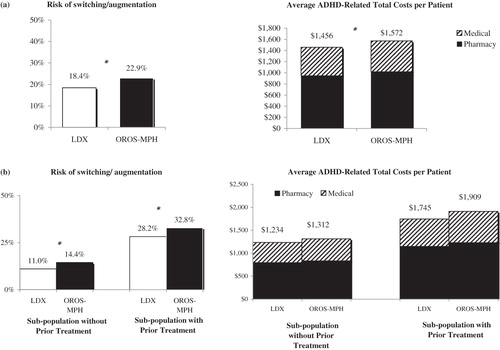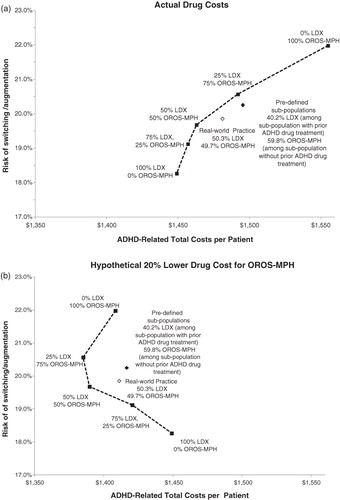Figures & data
Table 1. Baseline characteristics for adolescents.
Figure 1. Comparison of study outcomes for LDX vs OROS-MPH†. (a) Overall population‡; (b) Pre-defined sub-populations.‡,$. †Study outcomes were measured over the 12-month post-index period. ‡Mean and p-values were estimated using weighted t-tests for continuous variables. Tests adjusted for baseline characteristics by using IPTW. $p-values for trends across the pre-defined sub-populations for risk of switching/augmentation and ADHD-related costs were estimated based on generalized linear models with binomial distribution and normal distributions, respectively, adjusting for baseline characteristics using IPTW and index drugs. Both p-values were <0.001. *p-value significant at α=0.05.

Table 2. Prediction model for switching/augmentation on OROS-MPH.
Table 3. Comparison of outcomes for LDX vs OROS-MPH. Observed and predicted risk of switching/augmentation.
Table 4. Comparison of outcomes for LDX vs OROS-MPH. ADHD-related costs.
Figure 2. Outcomes achievable with individualized treatment with LDX and OROS-MPH. LDX, lisdexamfetamine dimesylate; OROS-MPH, osmotic-release oral system methylphenidate; ADHD, attention deficit hyperactivity disorder. The squares connected by the dashed black line illustrate different ways of allocating patients based on the stratified medicine approach; black diamond illustrates treatment allocation by pre-defined sub-populations (i.e., sub-populations with and without prior ADHD treatments); white diamond represents the observed real-world practice.

